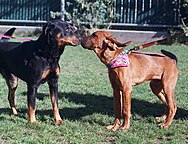Dog communication is the transfer of information between dogs, as well as between dogs and humans. Behaviors associated with dog communication are categorized into visual and vocal.[citation needed] Visual communication includes mouth shape and head position, licking and sniffing, ear and tail positioning, eye gaze, facial expression, and body posture. Dog vocalizations, or auditory communication, can include barks, growls, howls, whines and whimpers, screams, pants and sighs. Dogs also communicate via gustatory communication, utilizing scent and pheromones.[2]
Humans can communicate with dogs through a wide variety of methods. Broadly, this includes vocalization, hand signals, body posture and touch. The two species also communicate visually: through domestication, dogs have become particularly adept at "reading" human facial expressions, and they are able to determine human emotional status. When communicating with a human, their level of comprehension is generally comparable to a toddler.[citation needed]
- ^ a b Cite error: The named reference
coren2000was invoked but never defined (see the help page). - ^ Pageat, Patrick; Gaultier, Emmanuel (March 2003). "Current research in canine and feline pheromones". Veterinary Clinics of North America: Small Animal Practice. 33 (2): 187–211. doi:10.1016/S0195-5616(02)00128-6. PMID 12701508.


